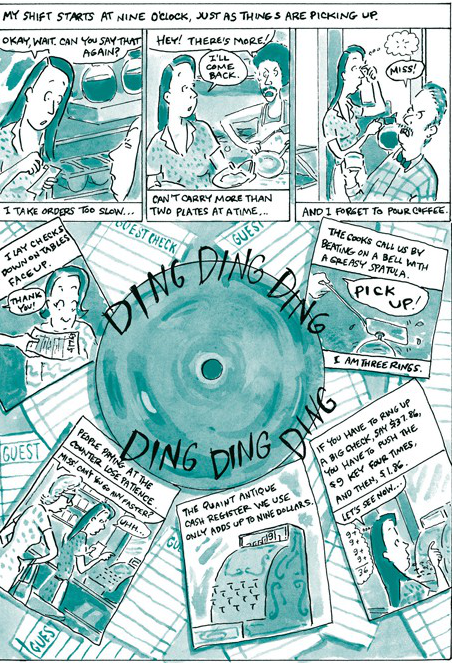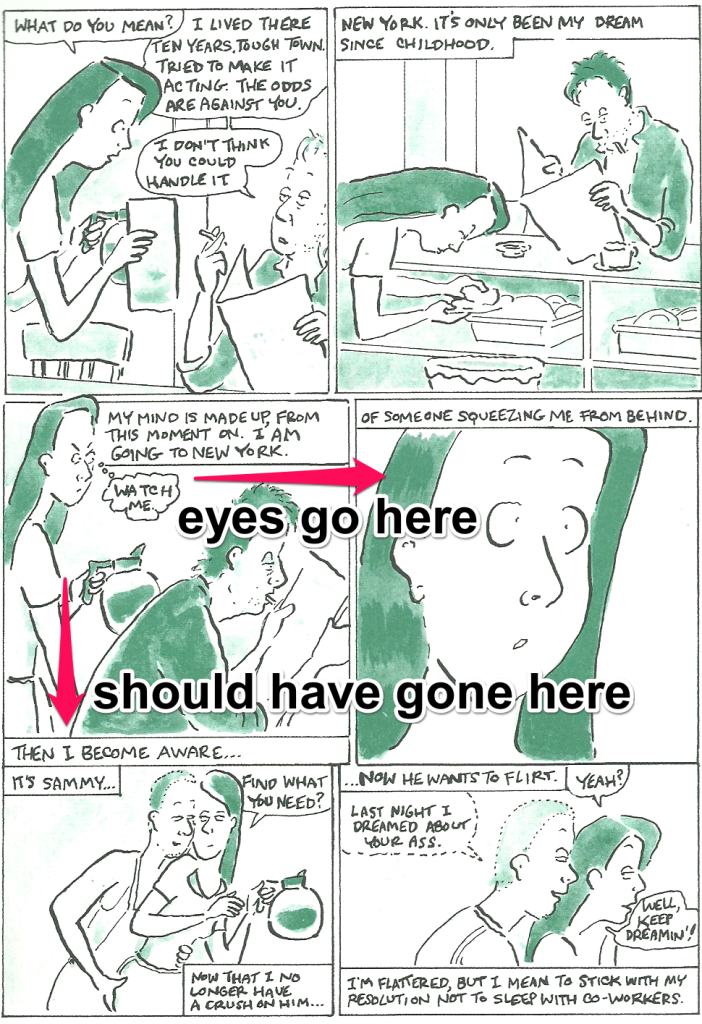 Mimi Pond’s graphic novel Over Easy (Drawn & Quarterly, 2014) captures a period of transition from hippies to punks in the 1970s. The description “fictionalized memoir” threw me for a loop. Was the main character, Margaret, Mimi Pond? Did these stories actually happen? Is Pond simply changing names to protect the other people in Over Easy? Or is it that she can’t remember exactly what happened, so she had to make some up? According to a post on her website, Pond was inspired by a restaurant in which she worked and includes a photo of all the waitresses from that time, suggesting that the graphic novel is pretty realistic overall. I’m able to move forward with a modicum of distrust, and I will refer to Margaret as a character, not the author.
Mimi Pond’s graphic novel Over Easy (Drawn & Quarterly, 2014) captures a period of transition from hippies to punks in the 1970s. The description “fictionalized memoir” threw me for a loop. Was the main character, Margaret, Mimi Pond? Did these stories actually happen? Is Pond simply changing names to protect the other people in Over Easy? Or is it that she can’t remember exactly what happened, so she had to make some up? According to a post on her website, Pond was inspired by a restaurant in which she worked and includes a photo of all the waitresses from that time, suggesting that the graphic novel is pretty realistic overall. I’m able to move forward with a modicum of distrust, and I will refer to Margaret as a character, not the author.
All images are pen with watercolor in blue-ish/green shades. The simple color palate gives the images an old feel, whereas a full color palate can cause a graphic novel to seem too cartoony. Bright colors would not have matched with Pond’s sketchy style, and it would have been hard to take this serious story, well, seriously.
Over Easy begins May 23, 1978. Margaret is the only character in a diner called The Imperial when the manager, Lazlo, comes spinning into the scene. At the time, Margaret is an art student, and the world of blue collar workers fascinates her. She exchanges a drawing for a free meal, but the restaurant is about to close for the day, so Lazlo gives her an IOU.
The story then jumps back to how Margaret wound up at that diner and why she is interested in drawing. Margaret attends San Diego City College during a time when grants are plentiful. Quickly, she tires of hippy students, their all-agreeing attitudes, and the crappy 70s hippy art they produce. She applies to and attends the California College of Arts and Crafts to be far enough from her parents in San Diego, but still close to home. But, before she can actually finish college, Margaret is informed that the grant money has run out.
This is when we get back to that diner. Margaret heads into The Imperial with her IOU and falls in love with the place. To be fair, the cooks are misogynistic dicks (one cook calls every waitress a “lying whore”), the waitresses are bitches (they call each other “cunt”), and these are totally Margaret’s people—neither hippies nor punks. The rest of the graphic novel introduces readers to the cast of characters in the diner, some of the customers, and describes Margaret’s climb from college dropout to dishwasher to waitress.
The plot of Over Easy sounds almost too, well, easy. Yet, Mimi Pond captures a moment of change in American history and details the internal responses of one citizen. Really, the book is character and observation driven. The characters are just delightful, and Pond’s drawing style makes the connection between what these people are saying and how they look. I especially enjoy how everyone has a cigarette hanging out of their mouths, even during work hours in a restaurant.

The cooks eye people on the streets suspiciously, suggesting their intense desire to leave right at 3:00 and not have to hang around and make orders a few minutes before the magic hour. They stare at the clocks, counting, watching, waiting. Helen’s wide open mouth and shrill directions show how dire the situation really is, even though it’s not. And so, someone must run to the door. I can picture these characters having better things to do with their lives, and they want out! The cooks and waitresses spend most of the day name calling and copping feels anyway; they’re exhausted.
For the most part, Pond uses basic square frames for her images, but some pages use a central object around which other images or words thematically tie together. Pond doesn’t do this too much, which is a relief. Some graphic novelists confuse clutter with style. Here’s an example: the bell that alerts waitresses that their order is ready tying together with the struggles (laid out like order checks) Margaret experiences on her first day as a waitress:
The large swirling words “DING DING DING DING DING DING” intensify the feelings that Margaret experiences as she gets confused, makes mistakes, and gets it wrong.
There are a number of places where the design choices don’t work as well. A page that has six simple frames seems easy enough, but the thoughts may appear at the top and bottom of a frame. If someone is thinking or talking near the top of the next frame, my eyes would go from top of frame to top of frame, causing me to miss what’s on the bottom of a frame. Here is an example:
I don’t typically like slice-of-life stories because they seem important only to the author. Yet, Mimi Pond shows why the 70s were an interesting time in America using unique viewpoints. While everyone around her is ingesting coke, weed, and speed, Margaret only snorts coke once after a fellow waitress offers it to sooth Margaret after a fight in the kitchen. The effect is not good, and we don’t hear about Margaret doing drugs again. She does, like her coworkers, find multiple sex partners, though Margaret’s rule is “don’t sleep with coworkers. Her coworkers’ rule seems to be “anything goes.” It’s hard for me to fathom having sex with everyone I find cute or snorting coke like it’s the most normal thing on the planet, but Pond integrates this part of the 70s culture in so smoothly and has Margaret comment on it in a way that shows she’s analyzing her surroundings. While I can’t relate, I can understand, and is that not the point of reading?
Over Easy was a fascinating read. I always wanted to know what bitchy waitresses Martha and Helen would do next, and I wanted to see in what way the cooks were trying to be smooth poets and cool guys. Lazlo held the whole thing together with his whimsical personality and strange rules. I didn’t want to befriend these people, but I liked being the outsider peeking in. The characters are like dysfunctional roommates or relatives, giving both a sense of love and hatred to each other. Riding along with Margaret while she navigates her life made this graphic novel a page turner.




This looks great! I would love to read more graphic novels….
LikeLiked by 1 person
Thanks for writing, Cathy! I really like reading graphic novels when there is a lot going on and I’m not able to keep up with my novel reading for GTL. If you click on my tag, “graphic novel,” you’ll see some other great titles you should be able to get at your library!
LikeLiked by 1 person
Oh great, thank you!
LikeLiked by 1 person
Great review! I hadn’t heard of “Over Easy”, but as a graphic novel enthusiast (actually more like obsessiest), I’ll definitely give it a try!
LikeLiked by 1 person
Thanks, Sarah! I usually start reading graphic novels around mid-semester because I have trouble keeping up with grading and reading longer novels. I have another review coming out Monday, and after that I have a graphic novel in the wings with “Bitch” something in the title!
LikeLiked by 1 person
[…] the end of October, I reviewed Pond’s graphic novel, Over Easy, and praised the marvelous characters and greenish-blue […]
LikeLike
[…] Read the full review here! […]
LikeLike
Hehe I’m in the Brighton library today and they had this book on the shelf! I was like ‘Yay!! Grab the Lapels reviewed!!” Halfway through it now and just wanted to comment on your blog lol! Hope you’re doing well! I’m behind on reading some of your reviews, hoping to read through them this week and get some more reading tips- loving this one so far!
LikeLiked by 1 person
Awesome! I thought it was a great book, and I don’t typically like books about restaurant life because they feel so familiar. Something about Mimi Pond felt very genuine, though, beyond the fact that she DID work in a diner.
LikeLike
[…] was under the assumption that it took her a very long time to write and illustrate her first book, Over Easy, which I reviewed last year. Pond’s 2017 graphic novel is another glimpse into her life as a […]
LikeLike
Thanks for the link. Sounds and looks interesting. Hard time to be a teenager–navigating all the pot holes of such a permissive sub-culture. Rest assured, not all of us were bed hopping and gobbling drugs. There was a lot of righteous push back and that wasn’t great either.
LikeLike
I’m starting think we’ve never found middle ground on anything in the States.
LikeLiked by 1 person